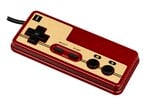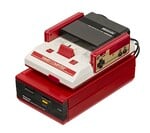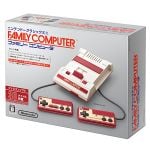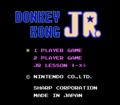Family Computer: Difference between revisions
YoshiFan08 (talk | contribs) No edit summary |
m (image comment) |
||
| (133 intermediate revisions by 40 users not shown) | |||
| Line 1: | Line 1: | ||
{{system | {{system infobox | ||
| | |image=[[File:Famicom.jpg|250px]]<br>Original model of the Family Computer | ||
|generation=Third | |generation=Third | ||
| | |release='''Family Computer:'''<br>{{flag list|Japan|July 15, 1983<ref>{{cite|author=Nintendo Co., Ltd.|date=March 31, 2003|title=Gaming for 5 to 95|url=https://www.sec.gov/Archives/edgar/vprr/03/9999999997-03-043511|format=|timestamp=|location=|publisher=SEC.gov|language=English|website=|isbn=|page=|accessdate=December 9, 2024|archive=https://web.archive.org/web/20141229023442/http://www.sec.gov/Archives/edgar/vprr/03/9999999997-03-043511|deadlink=y}}</ref>|ROC|1987|British HK|1991}} '''Nintendo Classic Mini: Family Computer:'''<br>{{flag list|Japan|November 10, 2016}} | ||
|ratings=Nintendo Classic Mini: Family Computer:{{ratings|cero=B}} | |ratings=Nintendo Classic Mini: Family Computer:{{ratings|cero=B}} | ||
| | |discontinued='''Family Computer:'''<br>September 25, 2003<ref name=Discontinue>http://www.webcitation.org/5nXieXX2B</ref><br> | ||
| | '''Nintendo Classic Mini: Family Computer:'''<br>April 2017 | ||
| | |predecessor={{wp|Color TV-Game}} | ||
|successor=[[Super Nintendo Entertainment System|Super Famicom]] | |||
}} | }} | ||
{{ | {{quote|If you were to strike up a friendship with a Japanese gamer and happened to ask him whether he owned a [[Nintendo Entertainment System|NES]] back in the '80s, you'd probably be met with a blank stare.|''{{wp|Official Nintendo Magazine}}''}} | ||
[[File: | [[File:Family Computer Logo.png|left|250px]] The '''Family Computer''' (often shortened to '''Famicom''') is a third-generation video game console created by [[Nintendo]]. The console would be redesigned for the {{wp|Western world|West}} as the [[Nintendo Entertainment System]] (NES) in 1985. The Famicom was released in Japan on July 15, 1983; Taiwan in 1987; and Hong Kong in 1991. Because the latter region previously saw an official release of the NES, the Hong Kong release of the Famicom was marketed as a "second-generation" hardware revision, adding the ability to toggle between PAL 50 Hz and PAL 60 Hz output.<ref>{{cite|author=Dentifritz|date=September 16, 2012|url=https://scanlines16.com/en/blog-3/retro-gaming/nintendo-nes-famicom/famicom-from-taiwan-et-autres-histoires-sur-la-distribution-asiatique/|publisher=Scanlines16.com|title=Famicom from Taiwan and other exciting stories about the Asian distribution.|language=English|archive=http://archive.today/2025.01.21-070356/https://scanlines16.com/en/blog-3/retro-gaming/nintendo-nes-famicom/famicom-from-taiwan-et-autres-histoires-sur-la-distribution-asiatique/|accessdate=January 20, 2025}}</ref><ref>{{cite|author=Akfamilyhome|date=April 1, 2020|url=https://www.youtube.com/watch?v=IToY_73pRHU|publisher=YouTube|title=A History of Nintendo's Hong Kong Releases|language=Cantonese & English (English subtitles available)|archive=https://web.archive.org/web/20240525112253/https://www.youtube.com/watch?v=IToY_73pRHU|accessdate=June 5, 2024}}</ref> Nintendo additionally arranged a deal with the Russian technology company Steepler in 1994 to permit the sale of a clone console called the Dendy in the former Soviet Union in exchange for providing equal distribution for the [[Super Nintendo Entertainment System]].<ref>{{cite|author=Игорь Пичугин|date=November 1, 1994|url=https://www.kommersant.ru/doc/94004|title=Соглашение Steepler и Nintendo|publisher=Газета "Коммерсантъ"|language=Russian|archive=https://web.archive.org/web/20190427025842/https://www.kommersant.ru/doc/94004|accessdate=June 1, 2024}}</ref><ref>{{cite|author=Семён Костин|date=December 14, 2021|url=https://dtf.ru/games/970617-legenda-o-slone-kak-it-kompaniya-steepler-sozdala-dendy-i-osnovala-rossiiskii-konsolnyi-rynok|title=Легенда о слоне: как IT-компания Steepler создала Dendy и основала российский консольный рынок|publisher=DTF|language=Russian|archive=https://web.archive.org/web/20240601223552/https://dtf.ru/games/970617-legenda-o-slone-kak-it-kompaniya-steepler-sozdala-dendy-i-osnovala-rossiiskii-konsolnyi-rynok|accessdate=June 1, 2024}}</ref><ref>{{cite|author=Олег Хохлов|date=August 9, 2016|title=Приставка Dendy: Как Виктор Савюк придумал первый в России поп-гаджет|url=https://secretmag.ru/business/trade-secret/nintendo-so-slonom-kak-viktor-savyuk-pridumal-pristavku-dendy.htm|publisher=Секрет фирмы|language=Russian|accessdate=December 9, 2024|archive=https://web.archive.org/web/20241201054908/https://secretmag.ru/business/trade-secret/nintendo-so-slonom-kak-viktor-savyuk-pridumal-pristavku-dendy.htm}}</ref> | ||
The '''Family Computer''' (often shortened to '''Famicom''') is the | |||
A few months after the July 1983 release of the Famicom, {{wp|Sharp Corporation|Sharp}} produced the {{wp|Nintendo Entertainment System models#Sharp Nintendo Television|Sharp C1 Famicom TV}}, a combined console and TV unit packaged with ''[[Donkey Kong Jr. + Jr. Sansū Lesson]]''. | |||
Famicom cartridges were about half the size of NES Game Paks, and were inserted in the top of the console. The cartridges more closely resembles an audio cassette rather than a video cassette for NES Game Paks, and Famicom cartridges can be found in different colors, such as red, yellow, and blue. | |||
By the release of ''[[Super Mario Bros.]]'', Nintendo had already sold over four million units.<ref>{{cite|language=ja|url=www.ndw.jp/post-714|title=上村雅之さん 大いに語る。 ファミリーコンピュータ インタビュー(後編)(2013年10月号より)|publisher=[[Nintendo DREAM|''Nintendo DREAM Web'']]|accessdate=June 18, 2023}}</ref> The redesigned '''New Famicom''' (often called the '''AV Famicom''') would release in Japan on December 1, 1993. The Famicom sold 19.35 million units in Japan and would be discontinued on September 25, 2003.<ref name=Discontinue /> | |||
==Accessories== | |||
===Famicom Controller=== | |||
[[File:Famicom-controller-I.jpg|upright=1.11|thumb|left|150px|The Player 1 Famicom Controller.]] | |||
The Famicom Controller is the basic controller that is hard-wired into the Family Computer. They could be stored on the sides of the system. Controller 1 has four buttons and a directional pad on a round-shaped case. {{button|nes|A}} and {{button|nes|B}} are stationed on the right, the {{button|nes|start}} and {{button|nes|select}} is in the middle, and the D-pad is on the left of the controller. This controller can pause the game. Controller 2 has two buttons with {{button|nes|start}} and {{button|nes|select}} being replaced with a volume slider and microphone. Nintendo later released a different form of the Famicom, the New Famicom (also known as the AV Famicom), which used a "dog-bone" design similar to the [[Super Nintendo Entertainment System#SNES Controller|Super Famicom controller]]. This design combines elements of the [[Game Boy]] and [[Super Nintendo Entertainment System|Super Famicom]] controller. Unlike the original Famicom controller, the New Famicom controllers used the same controller plugs as the ones found on the [[Nintendo Entertainment System]]. | |||
===''Family BASIC''=== | |||
{{main|Family BASIC}} | |||
In 1984, Sharp released the ''Playbox BASIC'' and ''Family BASIC'' accessories, allowing users to program in {{wp|BASIC}} on their Family Computers, and included characters of the [[Super Mario (franchise)|''Super Mario'' franchise]] as programmable sprites. It consists of a large cartridge and a keyboard. | |||
====Family BASIC Data Recorder==== | |||
[[File:FamilyBASICDataRecorder.png|thumb|150px|The Family BASIC Data Recorder along with a cassette tape and cables]] | |||
The Family BASIC Data Recorder is a cassette tape deck released alongside ''Family BASIC''. It can be powered by 4 AA batteries or a 6 volt power adapter. The Data Recorder features two 3.5mm mono data ports that you plug into the Famicom Keyboard's "write" and "save" ports. In ''Family BASIC'', the Data Recorder is used to save and load programs. Several games used the Data Recorder including the Famicom game ''[[Wrecking Crew]]''. When the game was later released for the [[Family Computer Disk System|Disk System]], it saved data onto the Disk Card. | |||
===Family Computer Disk System=== | |||
{{main|Family Computer Disk System}} | |||
[[File:Famicomdisksystemconsole.jpg|upright=1.11|thumb|left|150px|The Family Computer Disk System featuring the RAM Adapter and disk drive.]] | |||
In February 1986, the Family Computer Disk System add-on was released, and it enabled software to be played on the Famicom in the form of yellow Disk Card floppy disks. These disks could not only hold more data than typical cartridges at the time, but were rewritable through the Disk Writer kiosks. Later, Nintendo would create blue Disk Card floppy disks with a protective shutter which were primarily used for Disk Fax competitions. Nintendo would continue to support the Disk System up until 1993 with rewrite services through the Disk Writer continuing by mail until 2003. | |||
Several games were never released on the Famicom or NES but were only released on the Disk System, such as ''[[Super Mario Bros.: The Lost Levels]]''. Sometime in the early 1990s, Nintendo would partner with Simon & Toys Limited to distribute the Disk System in Hong Kong.<ref>{{cite|author=Nakamanga|date=September 30, 2019|url=youtu.be/MXuVDUUmYyo|title=Famicom and Disk System Hong Kong Version - Commercial|publisher=YouTube|accessdate=January 2, 2025}}</ref>{{better source}} | |||
===Famicom 3D System=== | |||
[[File:Famicom 3D System.png|thumb|200px|The Famicom 3D System with its adapter next to it]] | |||
The '''{{wp|Famicom 3D System}}''' is an accessory introduced in 1987 for the Famicom that connects to the system via an adapter that plugs into the expansion port. A version of the Famicom 3D System was also distributed by Sharp for the {{wp|Twin Famicom}}. The Famicom 3D System was compatible with a select few games including a ''[[Super Mario (franchise)|Super Mario]]'' game for the Disk System, ''[[Famicom Grand Prix II: 3D Hot Rally]]''. The 3D System was a commercial failure and was never released outside of Japan.<ref>{{cite|author=Plunkett, Luke|date=April 30, 2010|url=kotaku.com/nintendos-first-3d-technology-shot-a-spaceship-at-mario-5527760|language=en|title=Nintendo's First 3D Technology Shot A Spaceship At Mario's Face|publisher=Kotaku|accessdate=November 28, 2024}}</ref> | |||
==Nintendo Classic Mini: Family Computer== | ==Nintendo Classic Mini: Family Computer== | ||
[[File:NintendoClassicMini-FamilyComputer-Packshot.jpg|thumb|left|150px|The packaging of the Nintendo Classic Mini.]] | [[File:NintendoClassicMini-FamilyComputer-Packshot.jpg|thumb|left|150px|The packaging of the Nintendo Classic Mini.]] | ||
{{main|Classics#Nintendo Classic Mini: Family Computer}} | {{main|Classics#Nintendo Classic Mini: Family Computer}} | ||
On September 29, 2016, Nintendo announced the '''Nintendo Classic Mini: Family Computer''', the Family Computer counterpart of the [[Classics#NES Classic Edition|NES Classic Edition]]<ref> | On September 29, 2016, Nintendo announced the '''Nintendo Classic Mini: Family Computer''', the Family Computer counterpart of the [[Classics#NES Classic Edition|NES Classic Edition]],<ref>{{cite|date=September 29, 2016|url=www.nintendo.com/jp/topics/article/d2923b54-8552-11e6-9b38-063b7ac45a6d|language=ja|title=ファミコンが、手のひらサイズで"再"登場!|publisher=Nintendo|accessdate=May 31, 2024}}</ref> and was released alongside it in Japan on November 10, 2016. Like the NES Classic Edition, it includes 30 pre-installed Family Computer games, although with some differences in the game lineup, such as ''[[NES Open Tournament Golf|Mario Open Golf]]'' in place of ''[[Donkey Kong Jr. (game)|Donkey Kong Jr.]]'' Production for the console was discontinued in April 2017.<ref>{{cite|author=Sephazon, Robert|date=April 14, 2017|url=www.nintendolife.com/news/2017/04/the_famicom_classic_edition_has_now_also_been_discontinued|title=The Famicom Classic Edition Has Now Also Been Discontinued|language=en|publisher=Nintendo Life|accessdate=May 31, 2024}}</ref> | ||
{{br|left}} | {{br|left}} | ||
==Appearances in the ''Mario'' franchise== | ==Appearances in the ''Super Mario'' franchise== | ||
*In ''[[Super Mario Bros.: Peach-hime | *In ''[[Super Mario Bros.: Peach-hime Kyūshutsu Dai Sakusen!]]'', [[Mario]] himself owns a Famicom, on which he plays an unnamed video game which bears some similarities to ''[[Super Mario Bros.]]'' [[Princess Peach]] and [[Bowser]] also teleport through the television to which the Famicom is connected, although they do not appear to have any role at all in the game Mario is playing. | ||
*In ''[[WarioWare, Inc.: Mega Microgame$!]]'', 9-Volt owns a Famicom system which can be seen in the upper-left corner of the screen during his introduction cutscene. | *In ''[[WarioWare, Inc.: Mega Microgame$!]]'', 9-Volt owns a Famicom system which can be seen in the upper-left corner of the screen during his introduction cutscene. | ||
*In ''[[Paper Mario: The Thousand-Year Door]]'', during [[Princess Peach]]'s Interlude after Chapter 5, [[TEC | *In ''[[Paper Mario: The Thousand-Year Door]]'', during [[Princess Peach]]'s Interlude after Chapter 5, [[TEC]] asks Peach to drink an invisibility potion in order to secretly enter [[Grodus]]'s chamber and upload important data on a disk into the room's computer. When this happens, the computer screen shows the Famicom Disk System boot-up sequence. | ||
*In the Japanese version of ''[[WarioWare: Smooth Moves]]'', the microgame [[Super Nostalgic Entertainment System]] uses a Family Computer instead. | *In the Japanese version of ''[[WarioWare: Smooth Moves]]'', the microgame [[Super Nostalgic Entertainment System]] uses a Family Computer instead. The Famicom controller also appears as a sound effect icon in the [[Sound Studio]]. | ||
*In ''[[Super Paper Mario]]'', a Famicom can be seen on a shelf in one of [[Francis]]' rooms in his [[Fort Francis|fort]], among other Nintendo systems. | *In ''[[Super Paper Mario]]'', a Famicom can be seen on a shelf in one of [[Francis]]' rooms in his [[Fort Francis|fort]], among other Nintendo systems. | ||
*In ''[[WarioWare: D.I.Y.]]'', a green Family Computer cartridge makes up the bottom screen of the title screen. Also, the designs and colors of the cartridges in this game are based on those of the Famicom. | *In ''[[WarioWare: D.I.Y.]]'', a green Family Computer cartridge makes up the bottom screen of the title screen. Also, the designs and colors of the cartridges in this game are based on those of the Famicom. | ||
*In ''[[WarioWare Gold]]'', the Famicom appears as a collectible Nintendo [[list of souvenirs in WarioWare Gold|souvenir]]. | |||
*In ''[[WarioWare: Get It Together!]]'' in [[9-Volt]]'s Nintendo Classics level, the boss that appears in the intermission before the boss microgame has a Famicom controller for a face. | |||
<gallery> | <gallery> | ||
TheGreatMissionMarioPlayer.png|thumb|''Super Mario Bros.: Peach-hime | TheGreatMissionMarioPlayer.png|thumb|''Super Mario Bros.: Peach-hime Kyūshutsu Dai Sakusen!'' | ||
Family Computer microgame OMIW.jpg|''WarioWare: Smooth Moves'' (Japan) | Family Computer microgame OMIW.jpg|''WarioWare: Smooth Moves'' (Japan) | ||
SPM Francisroomright.png|''Super Paper Mario'' | SPM Francisroomright.png|''Super Paper Mario'' | ||
WWGIT Nintendo Classics Boss.jpg|''WarioWare: Get It Together!'' | |||
</gallery> | |||
==Gallery== | |||
===Logos=== | |||
<gallery> | |||
Family Computer Logo.png|Family Computer logo | |||
Famicom Family logo.svg|Famicom Family logo | |||
</gallery> | |||
===''Super Mario'' games=== | |||
This gallery does not include [[Family Computer Disk System]] or [[Nintendo Entertainment System]] games. | |||
<gallery> | |||
File:DK Famicom Cover Front.png|''[[Donkey Kong (game)|Donkey Kong]]'' | |||
File:Donkey Kong Jr. FC Box Art.jpg|''[[Donkey Kong Jr. (game)|Donkey Kong Jr.]]'' | |||
File:Mario Bros JP Box.png|''[[Mario Bros. (game)|Mario Bros.]]'' | |||
Ss dkjr sl.png|''[[Donkey Kong Jr. + Jr. Sansū Lesson]]'' | |||
Donkey Kong Jr. no Sansuu Asobi FC Box Art.jpg|''[[Donkey Kong Jr. Math]]'' | |||
PinballJpBoxart.png|''[[Pinball (game)|Pinball]]'' | |||
Golf FC Box.png|''[[Golf]]'' | |||
Donkey Kong 3 FC Box.png|''[[Donkey Kong 3]]'' | |||
Family BASIC FC Box Art.jpg|[[Family BASIC]] | |||
Family BASIC V3 FC Box Art.jpg|[[Family BASIC#Family BASIC V3|Family BASIC V3]] | |||
Wrecking Crew FC Box.png|''[[Wrecking Crew]]'' | |||
SMB FC Box.png|''[[Super Mario Bros.]]'' | |||
SMB3 FC Box.png|''[[Super Mario Bros. 3]]'' | |||
Dr Mario FC Box.png|''[[Dr. Mario (game)|Dr. Mario]]'' | |||
MOG FC Box.png|''[[NES Open Tournament Golf|Mario Open Golf]]'' | |||
Yoshi no Tamago FC Box Art.png|''[[Yoshi (game)|Yoshi]]'' | |||
SMUSA FC Box.png|''[[Super Mario Bros. 2|Super Mario USA]]'' | |||
YC FC Box.png|''[[Yoshi's Cookie]]'' | |||
Wario's Woods FC Box.png|''[[Wario's Woods (Nintendo Entertainment System)|Wario's Woods]]'' | |||
</gallery> | </gallery> | ||
== | ===Miscellaneous=== | ||
<gallery> | |||
Made in Wario site 9-Volt controller.gif|Pictogram of a Famicom controller from the official [[WarioWare (series)|''Made in Wario'']] website | |||
Nintendo Museum Nintendo Classics.png|Photo of the "Nintendo Classics" exhibit at the [[Nintendo Museum]] | |||
Famicom | Nintendo Museum Big Controller.png|Photo of the "Big Controller" exhibit at the Nintendo Museum | ||
</gallery> | |||
==Names in other languages== | |||
{{foreign names | |||
|Jpn=ファミリーコンピュータ | |||
|JpnR=Famirī Konpyūta | |||
|JpnM=Family Computer | |||
|Jpn2=ファミコン | |||
|Jpn2R=Famikon | |||
|Jpn2M=Famicom | |||
|Chi=紅白機 | |||
|ChiR=Hóngbái jī | |||
|ChiM=Famicom | |||
|Dut= | |||
|DutM= | |||
|FreA= | |||
|FreAM= | |||
|FreE= | |||
|FreEM= | |||
|Ger= | |||
|GerM= | |||
|Ita= | |||
|ItaM= | |||
|Kor= | |||
|KorR= | |||
|KorM= | |||
|Rus= | |||
|RusR= | |||
|RusM= | |||
|SpaA= | |||
|SpaE= | |||
|SpaEM= | |||
}} | |||
==References== | ==References== | ||
<references/> | <references/> | ||
{{ | |||
==External links== | |||
{{NIWA|FireEmblem=Family Computer|MetroidWiki=Famicom|NWiki=1|StarfyWiki=Famicom|StrategyWiki=Category:NES|WikiBound=Nintendo Entertainment System|ZeldaWiki=Famicom}} | |||
*[https://www.nintendo.com/jp/famicom/index.html Official Famicom 40th Anniversary site (Nintendo JP)] | |||
{{NES}} | {{NES}} | ||
{{ | {{Systems}} | ||
[[Category: | [[Category:Systems]] | ||
[[ | [[it:Family Computer]] | ||
Latest revision as of 07:34, April 2, 2025
| Family Computer | |||
|---|---|---|---|
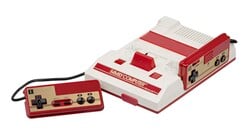 Original model of the Family Computer | |||
| Generation | Third generation | ||
| Release date | Family Computer: Nintendo Classic Mini: Family Computer: | ||
| Discontinued | Family Computer: September 25, 2003[2] Nintendo Classic Mini: Family Computer: | ||
| Ratings | Nintendo Classic Mini: Family Computer:
| ||
| Predecessor | Color TV-Game | ||
| Successor | Super Famicom | ||
- “If you were to strike up a friendship with a Japanese gamer and happened to ask him whether he owned a NES back in the '80s, you'd probably be met with a blank stare.”
- —Official Nintendo Magazine
The Family Computer (often shortened to Famicom) is a third-generation video game console created by Nintendo. The console would be redesigned for the West as the Nintendo Entertainment System (NES) in 1985. The Famicom was released in Japan on July 15, 1983; Taiwan in 1987; and Hong Kong in 1991. Because the latter region previously saw an official release of the NES, the Hong Kong release of the Famicom was marketed as a "second-generation" hardware revision, adding the ability to toggle between PAL 50 Hz and PAL 60 Hz output.[3][4] Nintendo additionally arranged a deal with the Russian technology company Steepler in 1994 to permit the sale of a clone console called the Dendy in the former Soviet Union in exchange for providing equal distribution for the Super Nintendo Entertainment System.[5][6][7]
A few months after the July 1983 release of the Famicom, Sharp produced the Sharp C1 Famicom TV, a combined console and TV unit packaged with Donkey Kong Jr. + Jr. Sansū Lesson.
Famicom cartridges were about half the size of NES Game Paks, and were inserted in the top of the console. The cartridges more closely resembles an audio cassette rather than a video cassette for NES Game Paks, and Famicom cartridges can be found in different colors, such as red, yellow, and blue.
By the release of Super Mario Bros., Nintendo had already sold over four million units.[8] The redesigned New Famicom (often called the AV Famicom) would release in Japan on December 1, 1993. The Famicom sold 19.35 million units in Japan and would be discontinued on September 25, 2003.[2]
Accessories[edit]
Famicom Controller[edit]
The Famicom Controller is the basic controller that is hard-wired into the Family Computer. They could be stored on the sides of the system. Controller 1 has four buttons and a directional pad on a round-shaped case. and
are stationed on the right, the
and
is in the middle, and the D-pad is on the left of the controller. This controller can pause the game. Controller 2 has two buttons with
and
being replaced with a volume slider and microphone. Nintendo later released a different form of the Famicom, the New Famicom (also known as the AV Famicom), which used a "dog-bone" design similar to the Super Famicom controller. This design combines elements of the Game Boy and Super Famicom controller. Unlike the original Famicom controller, the New Famicom controllers used the same controller plugs as the ones found on the Nintendo Entertainment System.
Family BASIC[edit]
- Main article: Family BASIC
In 1984, Sharp released the Playbox BASIC and Family BASIC accessories, allowing users to program in BASIC on their Family Computers, and included characters of the Super Mario franchise as programmable sprites. It consists of a large cartridge and a keyboard.
Family BASIC Data Recorder[edit]
The Family BASIC Data Recorder is a cassette tape deck released alongside Family BASIC. It can be powered by 4 AA batteries or a 6 volt power adapter. The Data Recorder features two 3.5mm mono data ports that you plug into the Famicom Keyboard's "write" and "save" ports. In Family BASIC, the Data Recorder is used to save and load programs. Several games used the Data Recorder including the Famicom game Wrecking Crew. When the game was later released for the Disk System, it saved data onto the Disk Card.
Family Computer Disk System[edit]
- Main article: Family Computer Disk System
In February 1986, the Family Computer Disk System add-on was released, and it enabled software to be played on the Famicom in the form of yellow Disk Card floppy disks. These disks could not only hold more data than typical cartridges at the time, but were rewritable through the Disk Writer kiosks. Later, Nintendo would create blue Disk Card floppy disks with a protective shutter which were primarily used for Disk Fax competitions. Nintendo would continue to support the Disk System up until 1993 with rewrite services through the Disk Writer continuing by mail until 2003.
Several games were never released on the Famicom or NES but were only released on the Disk System, such as Super Mario Bros.: The Lost Levels. Sometime in the early 1990s, Nintendo would partner with Simon & Toys Limited to distribute the Disk System in Hong Kong.[9][better source needed]
Famicom 3D System[edit]
The Famicom 3D System is an accessory introduced in 1987 for the Famicom that connects to the system via an adapter that plugs into the expansion port. A version of the Famicom 3D System was also distributed by Sharp for the Twin Famicom. The Famicom 3D System was compatible with a select few games including a Super Mario game for the Disk System, Famicom Grand Prix II: 3D Hot Rally. The 3D System was a commercial failure and was never released outside of Japan.[10]
Nintendo Classic Mini: Family Computer[edit]
- Main article: Classics § Nintendo Classic Mini: Family Computer
On September 29, 2016, Nintendo announced the Nintendo Classic Mini: Family Computer, the Family Computer counterpart of the NES Classic Edition,[11] and was released alongside it in Japan on November 10, 2016. Like the NES Classic Edition, it includes 30 pre-installed Family Computer games, although with some differences in the game lineup, such as Mario Open Golf in place of Donkey Kong Jr. Production for the console was discontinued in April 2017.[12]
Appearances in the Super Mario franchise[edit]
- In Super Mario Bros.: Peach-hime Kyūshutsu Dai Sakusen!, Mario himself owns a Famicom, on which he plays an unnamed video game which bears some similarities to Super Mario Bros. Princess Peach and Bowser also teleport through the television to which the Famicom is connected, although they do not appear to have any role at all in the game Mario is playing.
- In WarioWare, Inc.: Mega Microgame$!, 9-Volt owns a Famicom system which can be seen in the upper-left corner of the screen during his introduction cutscene.
- In Paper Mario: The Thousand-Year Door, during Princess Peach's Interlude after Chapter 5, TEC asks Peach to drink an invisibility potion in order to secretly enter Grodus's chamber and upload important data on a disk into the room's computer. When this happens, the computer screen shows the Famicom Disk System boot-up sequence.
- In the Japanese version of WarioWare: Smooth Moves, the microgame Super Nostalgic Entertainment System uses a Family Computer instead. The Famicom controller also appears as a sound effect icon in the Sound Studio.
- In Super Paper Mario, a Famicom can be seen on a shelf in one of Francis' rooms in his fort, among other Nintendo systems.
- In WarioWare: D.I.Y., a green Family Computer cartridge makes up the bottom screen of the title screen. Also, the designs and colors of the cartridges in this game are based on those of the Famicom.
- In WarioWare Gold, the Famicom appears as a collectible Nintendo souvenir.
- In WarioWare: Get It Together! in 9-Volt's Nintendo Classics level, the boss that appears in the intermission before the boss microgame has a Famicom controller for a face.
Gallery[edit]
Logos[edit]
Super Mario games[edit]
This gallery does not include Family Computer Disk System or Nintendo Entertainment System games.
Miscellaneous[edit]
Pictogram of a Famicom controller from the official Made in Wario website
Photo of the "Nintendo Classics" exhibit at the Nintendo Museum
Names in other languages[edit]
| Language | Name | Meaning | Notes |
|---|---|---|---|
| Japanese | ファミリーコンピュータ[?] Famirī Konpyūta |
Family Computer | |
| ファミコン[?] Famikon |
Famicom | ||
| Chinese | 紅白機[?] Hóngbái jī |
Famicom |
References[edit]
- ^ Nintendo Co., Ltd. (March 31, 2003). Gaming for 5 to 95. SEC.gov (English). Archived December 29, 2014, 02:34:42 UTC from the original via Wayback Machine. Retrieved December 9, 2024.
- ^ a b http://www.webcitation.org/5nXieXX2B
- ^ Dentifritz (September 16, 2012). Famicom from Taiwan and other exciting stories about the Asian distribution.. Scanlines16.com (English). Retrieved January 20, 2025. (Archived January 21, 2025, 07:03:56 UTC via archive.today.)
- ^ Akfamilyhome (April 1, 2020). A History of Nintendo's Hong Kong Releases. YouTube (Cantonese & English (English subtitles available)). Retrieved June 5, 2024. (Archived May 25, 2024, 11:22:53 UTC via Wayback Machine.)
- ^ Игорь Пичугин (November 1, 1994). Соглашение Steepler и Nintendo. Газета "Коммерсантъ" (Russian). Retrieved June 1, 2024. (Archived April 27, 2019, 02:58:42 UTC via Wayback Machine.)
- ^ Семён Костин (December 14, 2021). Легенда о слоне: как IT-компания Steepler создала Dendy и основала российский консольный рынок. DTF (Russian). Retrieved June 1, 2024. (Archived June 1, 2024, 22:35:52 UTC via Wayback Machine.)
- ^ Олег Хохлов (August 9, 2016). Приставка Dendy: Как Виктор Савюк придумал первый в России поп-гаджет. Секрет фирмы (Russian). Retrieved December 9, 2024. (Archived December 1, 2024, 05:49:08 UTC via Wayback Machine.)
- ^ 上村雅之さん 大いに語る。 ファミリーコンピュータ インタビュー(後編)(2013年10月号より). Nintendo DREAM Web (Japanese). Retrieved June 18, 2023.
- ^ Nakamanga (September 30, 2019). Famicom and Disk System Hong Kong Version - Commercial. YouTube. Retrieved January 2, 2025.
- ^ Plunkett, Luke (April 30, 2010). Nintendo's First 3D Technology Shot A Spaceship At Mario's Face. Kotaku (English). Retrieved November 28, 2024.
- ^ September 29, 2016. ファミコンが、手のひらサイズで"再"登場!. Nintendo (Japanese). Retrieved May 31, 2024.
- ^ Sephazon, Robert (April 14, 2017). The Famicom Classic Edition Has Now Also Been Discontinued. Nintendo Life (English). Retrieved May 31, 2024.

